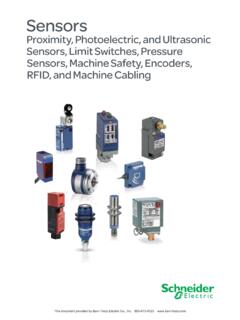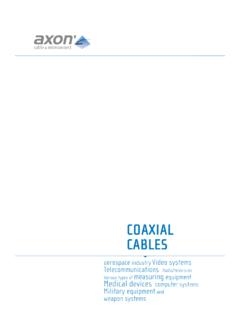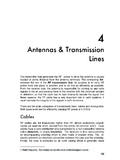Transcription of Modicon Remote I/O Cable System Planning and Installation ...
1 Modicon Remote I/O Cable System Planning and Installation guide 890 USE 101 00 eng Version 35014629 00. This document provided by Barr-Thorp Electric Co., Inc. 800-473-9123 2. This document provided by Barr-Thorp Electric Co., Inc. 800-473-9123 Table of Contents Safety Information .. 7. About the Book .. 9. Chapter 1 Remote I/O Networks A Communications Overview .. 11. At a Glance .. 11. RIO Network Communications .. 12. Processing Nodes on the RIO Network.. 13. RIO Drop Addressing .. 15. RIO Network Cable System .. 16. RIO Network Node Part Number Summary .. 18. Chapter 2 Planning and Designing an RIO Cable System .. 19. At a Glance .. 19. Linear Cable Topologies .. 20. Hot Standby Cable Topologies .. 24. Trunk Splitter Use .. 28. Illegal Coaxial Cable Topologies .. 31. Using Fiber Optics in an RIO System .. 34. RIO System Design.. 40. Choosing Coaxial Cables for an RIO Network .. 42. Coaxial Cable Characteristics .. 44. Electrical Characteristics of Coaxial Media Components.
2 45. EMI/RFI Considerations in a Coaxial Cable Routing Plan .. 47. Tap Connections and Locations .. 48. Grounding and Surge Suppression .. 50. Terminating a Coaxial Cable System .. 51. Designing a Coaxial Cable System to an Attenuation Limit .. 52. Attenuation Considerations in an Optical Path .. 56. Maximum Number of Repeaters and Jitter Considerations.. 58. Planning RIO Drops .. 61. Chapter 3 RIO Network Hardware Components .. 67. At a Glance .. 67. RG-6 Cable .. 68. 3. This document provided by Barr-Thorp Electric Co., Inc. 800-473-9123 RG-11 Cable .. 69. Semirigid Cable .. 70. Selecting Fiber Optic Cable .. 71. Hardware Overview .. 72. Tap Specifications .. 74. Splitter Specifications.. 76. F Connectors for Coaxial Cables .. 78. F Adapters for Semirigid Cable .. 80. BNC Connectors and Adapters .. 81. Network Terminators .. 83. Self-terminating F Adapter Options .. 85. Ground Blocks .. 86. Surge Suppressors .. 88. Fiber Optic Repeater .. 90. Recommended Materials for Fiber Optic Links.
3 93. Chapter 4 Installing an RIO Network .. 95. At a Glance .. 95. Installation Overview .. 96. RG-6 Cable Connections .. 97. RG-6 Cable Installation Tool .. 98. Preparing RG-6 Cable for a Connector .. 100. Installing F Connectors on Quad Shield RG-6 Cable .. 102. Installing BNC or Self-terminating F Connectors on RG-6 Cable .. 105. RG-11 Cable Connections .. 107. The RG-11 Installation Tool .. 108. Installing F Connectors on RG-11 Cable .. 109. Semirigid Cable Connections.. 113. Semirigid Cable Installation Tools .. 114. Preparing a Semirigid Cable for a Connector .. 115. Installing F Connectors on Semirigid Cable .. 116. Semirigid Trunk Cable Tap Port Connections .. 117. Providing Line Termination on the Drop Cable .. 118. Connecting/Disconnecting a Drop Cable at a Tap.. 120. Installing Fiber Optic Repeaters.. 122. Terminating the Trunk Cable .. 126. Installing the Ground Point.. 127. Chapter 5 Testing and Maintaining an RIO Network .. 129. At a Glance .. 129. Maintenance and Testing Requirements.
4 130. Coax RIO System Network Integrity .. 132. Problem Sources on an RIO Network .. 135. On-line and Off-line Error Isolation .. 137. Troubleshooting Fiber Optic Repeaters .. 138. 4. This document provided by Barr-Thorp Electric Co., Inc. 800-473-9123 Appendices .. 141. At a Glance .. 141. Appendix A RIO Cable Material Suppliers.. 143. RIO Cable Material Suppliers .. 143. Glossary .. 147. Index .. 157. 5. This document provided by Barr-Thorp Electric Co., Inc. 800-473-9123 6. This document provided by Barr-Thorp Electric Co., Inc. 800-473-9123 Safety Information . Important Information NOTICE Read these instructions carefully, and look at the equipment to become familiar with the device before trying to install, operate, or maintain it. The following special messages may appear throughout this documentation or on the equipment to warn of potential hazards or to call attention to information that clarifies or simplifies a procedure. The addition of this symbol to a Danger or Warning safety label indicates that an electrical hazard exists, which will result in personal injury if the instructions are not followed.
5 This is the safety alert symbol. It is used to alert you to potential personal injury hazards. Obey all safety messages that follow this symbol to avoid possible injury or death. DANGER. DANGER indicates an imminently hazardous situation, which, if not avoided, will result in death or serious injury. WARNING. WARNING indicates a potentially hazardous situation, which, if not avoided, can result in death, serious injury, or equipment damage. 890 USE 101 00 October 2006 7. This document provided by Barr-Thorp Electric Co., Inc. 800-473-9123 Safety Information CAUTION. CAUTION indicates a potentially hazardous situation, which, if not avoided, can result in injury or equipment damage. PLEASE NOTE Electrical equipment should be installed, operated, serviced, and maintained only by qualified personnel. No responsibility is assumed by Schneider Electric for any consequences arising out of the use of this material. 2007 Schneider Electric. All Rights Reserved. 8 890 USE 101 00 October 2006.
6 This document provided by Barr-Thorp Electric Co., Inc. 800-473-9123 About the Book At a Glance Document Scope This manual is intended for the design engineer, Cable System installer and network manager involved with a Modicon Remote I/O (RIO) network. The manual describes: z design, Installation , test, and maintenance procedures for the RIO network z required media hardware , cables, taps, connectors, fiber optic options, tools and approved optional hardware for special situations and environments z RIO communication processing devices used with the Quantum Automation Series CPUs and the 984 family of PLCs z recommended Installation and maintenance tests for the RIO network Validity Note The data and illustrations found in this book are not binding. We reserve the right to modify our products in line with our policy of continuous product development. The information in this document is subject to change without notice and should not be construed as a commitment by Schneider Electric.
7 User Comments We welcome your comments about this document. You can reach us by e-mail at 890 USE 101 00 October 2006 9. This document provided by Barr-Thorp Electric Co., Inc. 800-473-9123 About the Book 10 890 USE 101 00 October 2006. This document provided by Barr-Thorp Electric Co., Inc. 800-473-9123 Remote I/O Networks A. Communications Overview 1. At a Glance Overview This chapter provides an overview of Remote I/O (RIO) networks. What's in this This chapter contains the following topics: Chapter? Topic Page RIO Network Communications 12. Processing Nodes on the RIO Network 13. RIO Drop Addressing 15. RIO Network Cable System 16. RIO Network Node Part Number Summary 18. 890 USE 101 00 October 2006 11. This document provided by Barr-Thorp Electric Co., Inc. 800-473-9123 Communications Overview RIO Network Communications Overview Modicon 's RIO network is a high speed ( Mbit/s) local area network (LAN) that uses commercially available coaxial Cable and CATV media technology.
8 RIO. supports: z Discrete and register data to input and output module communications z ASCII message transmissions to and from certain RIO drop adapters Data Transfer PLCs service their drop adapters at the beginning and end of logic segments when Consistency Ladder programming is used, or, for IEC, before and after all sections have been executed. Most data transfers between head and Remote drop take less than 1 ms. A CRC 16 message frame check assures that RIO messages will arrive reliably and completely error-checked at the proper destination node. How Messages A message initiated by the RIO head processor travels along the network's Cable are Transmitted System and is received by all RIO adapters. The RIO adapter with the address specified in the message can then transmit a response message back to the RIO. head within a specific time period. If the drop adapter does not respond, the same message is sent again. The process of resending the message after no response is called a retry.
9 If the adapter does not respond to several retries, the drop is declared dead. On each successive scan of the PLC, the RIO head attempts to re-establish communications with the adapter only one attempt per scan will be made to communicate with a dead drop until the adapter is successfully brought back up. Predictable As a high speed LAN, RIO must support applications that are very time-critical. In Speeds for Time- this respect, RIO has several advantages over other proprietary PLC. critical communication methods. These advantages include: Applications z HDLC protocol implementation makes the RIO data transfer speed very predictable z The PLC services each node using a consistent communications method the I/. O drops are always updated in a determinate time period that can be calculated based on the number of segments or sections in the user logic program z Only one node transmits at a given time, so message collisions do not occur . each node is able to transmit on the network in a determinate time period z RIO has high data integrity due to the frame check sequence and error checking at the physical protocol layer 12 890 USE 101 00 October 2006.
10 This document provided by Barr-Thorp Electric Co., Inc. 800-473-9123 Communications Overview Processing Nodes on the RIO Network Overview The RIO network supports communications between a PLC and one or more drops of I/O modules dispersed throughout your local area , your manufacturing or processing facility. All messages on the RIO network are initiated by a master node called the RIO head or processor. All other nodes on the network communicate with the RIO head via RIO adapters located at the drops. The network is proprietary, and Schneider Electric processing nodes must be used throughout the RIO network. RIO Processors RIO is fundamentally a single-master network, and the RIO processor is the master node. The RIO processor is located at the PLC at the head-end of the RIO network. Depending on the type of PLC you are using, the RIO processor can be implemented in hardware as an option module that mounts beside the PLC or as a board built into the PLC. PLC Type RIO Processor Dynamic Range Max.









